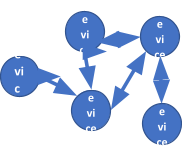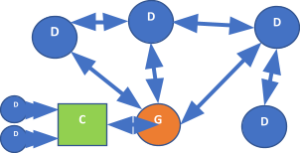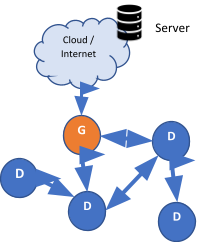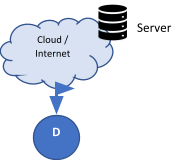IoT (Internet of Things) makes things (devices) communicable and smarter. In a typical IoT implementation there are diverse types of things and devices. Devices can use a variety of communication ports and protocols depending on their specific functionalities and the technologies they employ.
On a broader level we can classify the things that communicate and share information as one of the below
- End device: The smart sensor or device, control unit with multiple sensors wired to it. The devices communicate with each other or to the control unit.


- Gateway device: Multiple devices communicate in a Mesh or Star network to a central Gateway which in turn communicates with the Server.
E.g., A smart electricity meter system with multiple meters communicating to a gateway which in turn communicates with the server.


- Device to Server / Gateway to Server: Typically, over Ethernet / Wi-Fi / LTE / GPRS backbone.
E.g., Vehicle tracking systems, equipment monitoring systems, Smart metering systems.


For Device to Device / Device to Gateway, the ports and protocols commonly used by IoT devices are as below:
- Wired communication ports and protocols like Ethernet (TCP, HTTP, FTP) RS485 (Modbus), USB UART, CAN, Profibus and others.
- Wireless communication ports and protocols like Wi-Fi, BLE, GPRS/ LTE, RF (ZigBee, 6LOWPAN), LoRa and others.
For Device to Server / Gateway to Server / Server to Server, the ports and protocols commonly used by IoT devices are as below:
- HTTP/HTTPS (Port 80/443): Many IoT devices use HTTP or HTTPS protocols for communication over the internet. These protocols commonly utilize ports 80 and 443, respectively.
- MQTT (Message Queuing Telemetry Transport) (Port 1883/8883): MQTT is a lightweight messaging protocol often used for IoT devices to publish and subscribe to data streams. It typically uses ports 1883 (non-secure) and 8883 (secure with TLS/SSL).
- CoAP (Constrained Application Protocol) (Port 5683/5684): CoAP is a protocol designed for resource-constrained devices in low-power networks. It typically uses ports 5683 (non-secure) and 5684 (secure with DTLS).
- AMQP (Advanced Message Queuing Protocol) (Port 5672): AMQP is a messaging protocol that provides a robust and flexible way for IoT devices to exchange data. It commonly uses port 5672.
- WebSocket (Port 80/443): WebSocket is a communication protocol that enables bidirectional, full-duplex communication between IoT devices and servers. It can utilize ports 80 and 443, like HTTP/HTTPS.
- CoIP (Constrained Interoperable Protocol) (Port 5682): CoIP is a lightweight protocol specifically designed for resource constrained IoT devices. It often uses port 5682.
- Modbus (Port 502): Modbus is a popular protocol used in industrial IoT applications for communication between devices and control systems. It typically uses port 502.
It is important to note that the actual port numbers used by IoT devices can vary based on the specific implementation and network configuration.
Some IoT devices may use proprietary protocols and ports specific to the manufacturer or application.
Source-right is a product engineering solutions and services company. With deep expertise in IoT hardware and server software, source-right helps customers to choose the right technology stack and build the right IoT solutions.
